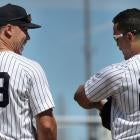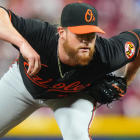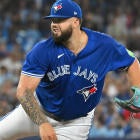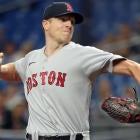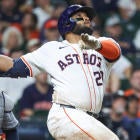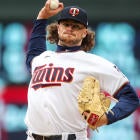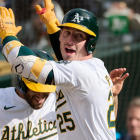This shouldn't be groundbreaking, and you shouldn't need me to tell you at this point, but as spring action gets underway, it bears repeating: Don't worry about spring training stats.
Should you ignore them completely? Maybe not entirely, but ... maybe! The sample sizes are tiny -- Pete Alonso led all players with 75 plate appearances last spring, or 24 fewer than he had in any month during the regular season -- and the level of competition is all over the place. Lewis Brinson has homered twice in his first four spring games, against a level of competition roughly comparable to Triple-A. There's just too much noise in the numbers, and you might be better off not looking at a spring leaderboard once.
But that does not mean you can ignore the spring entirely and still win your Fantasy league. The results may not matter much -- Brinson's .278/.304/.593 line didn't lead to any notable success in the majors last year — but there's a whole lot that does. You just have to sort through the noise to find out what might actually matter. You have to focus on the process.
That's what this piece will try to help you do. Six things you absolutely should pay attention to in spring that don't count in the box scores are:
- Injuries
- Lineup News
- Position Battles
- Mechanical Changes
- Velocity Readings and New Pitches
- Prospects Gaining Hype
You don't necessarily want to upend your entire draft strategy because someone added a mph of velocity, or his manager suggested he may bat second instead of fifth, but you certainly need to be paying attention. Scott White's Spring Training Notes columns will be a key resource for keeping up with the day-to-day storylines, as will the Mining The News column at FanGraphs.com, but with this piece, I want to put these six categories of spring trends/stories together, along with some examples of what we're seeing and hearing.
Note: This piece will be updated as spring goes on. The most recent update came on March 5.
Injuries
This is the most obviously impactful category, and it shouldn't need much explanation. Injuries don't just keep players out of action, but they delay the process of getting ready for the season, which can lead to slow starts. And if guys return too aggressively, things can linger through the rest of the season. Even a seemingly minor issue can unexpectedly derail a season. Spring matters for the players certainly, and if they aren't 100 percent to start the season, that's a huge warning sign.
- Chris Sale (elbow) — Well, this used to be just an illness that was going to delay Sale's availability for Opening Day. Now it's a flexor injury in his elbow that threatens to derail his whole season. I'm not taking him off my draft board, but I wouldn't touch him inside of the top 100.
- Blake Snell (elbow) — Snell was shut down from throwing after having an injection in recent days, though he was able to play catch in recent days, and should throw a bullpen session Friday. Assuming no setbacks — never a sure thing — Snell figures to be ready for Opening Day, though this obviously increases his risk.
- Giancarlo Stanton (calf) — Stanton is unlikely to be ready for opening day due to a calf strain, and people are predictably panicking. If you ask me, this injury figures to make Stanton an even better value for 2020.
- Aaron Judge (shoulder/pec) — Judge hopes to be ready for Opening Day, but at this point it isn't even clear what the underlying issue is. He's undergone plenty of tests, but they just don't have an answer at this point. Judge said he needs about 30 at-bats in game action to be ready to play, and while there's still some time for that, it's running out quickly. If he isn't in the lineup in Spring Training in the next week or so, it's hard to see how Stanton will get up to speed in time.
- Tyler Beede (elbow) — Beede has a flexor and UCL strain, though Tommy John surgery is not expected at this point. Of course, that doesn't mean it won't happen, and Beede will likely miss a significant time rehabbing from this injury. It's a shame, because Beede has really good stuff and could have been a late-round sleeper pitching half his games in Oracle Park.
- Freddie Freeman (elbow) —Freeman is dealing with some soreness and inflammation in his surgically repaired elbow. He's taking a few days off, but there isn't any concern as of now about his chances to be ready for Opening Day. However, you have to be at least a little bit concerned after he underwent offseason surgery to try to fix the elbow that has been nagging at him for years.
- Griffin Canning (elbow) — Canning was diagnosed with "chronic changes" to his UCL, which means … something! It isn't good news, but it also isn't a torn UCL, so it could certainly be worse. He told reporters Friday he believes it is just normal wear and tear, but he is set for further testing in the coming days before we get a full diagnosis. Canning remains a solid late-round buy, but there's certainly a chance he doesn't make any kind of impact this season.
- J.D. Davis (shoulder) — Davis injured his shoulder making a diving attempt on a ball at third base, but an MRI didn't show any structural damage. What it means for his availability to begin the season remains to be seen, but Davis is still a viable late-round target assuming he won't miss too much time.
- Alex Verdugo (back) — Verdugo hasn't been able to play since last August, which is … a long time! The Red Sox obviously aren't concerned about the long-term ramifications of the injury, having acquired Verdugo as the centerpiece for Mookie Betts, but it seems unlikely he will be ready for opening day.
- Brendan Rodgers (shoulder) — Rodgers is coming back from a torn labrum in his shoulder, and likely won't be major-league ready until May. He's a solid late-round sleeper target, though given the injury and the Rockies' crowded infield, it may be a while before he is able to force his way into the conversation. The good news is, Rodgers will begin playing DH in spring games this week.
- Andrew McCutchen (knee) — McCutchen is taking his rehab from a torn ACL slowly, and he will not be ready for Opening Day, manager Joe Girardi told reporters Friday. The hope is McCutchen will be ready sometime in April.
Lineup News
If nothing else, hitting higher in the order gives you more opportunities to put up numbers because you'll bat more often. Of course, there are other benefits beyond that: You get more run-producing opportunities higher in the lineup; and most teams are more likely to let players run from the leadoff spot than elsewhere. Managers will tinker in the spring, but it's worth keeping an eye on trends to see how teams are considering building their lineups.
- Todd Frazier seems to be the favorite to bat cleanup for the Rangers on Opening Day, though that could just be because the Rangers will likely face Marco Gonzales in the first game. He will likely hit between Joey Gallo and Willie Calhoun.
- Andrew Benintendi is likely to bat leadoff, according to MLB.com. Even without Mookie Betts, this still figures to be an excellent Red Sox lineup, so if Benintendi can just get back to his 2018 levels, there's a ton of potential for counting stats here. Of course, if he struggles out of the top spot as he did last season, don't be surprised to see Alex Verdugo get a shot whenever he is healthy enough to play.
- Bo Bichette will bat leadoff for the Blue Jays. Cavan Biggio figures to slide in behind him, with Lourdes Gurriel third and Vladimir Guerrero in the cleanup slot. Things are a bit less obvious after that, but Travis Shaw will hit either fifth or sixth.
Position Battles
Playing time is everything in Fantasy. It's more important than talent, even. And spring is the time when teams are tinkering with their rosters, figuring out who will be a part of the opening day lineup. That lineup won't be the one they go with for the full season, but a young player with promise getting his foot in the door at the start of the season is a good way to ensure he stays in an everyday role.
- Nick Senzel seems to have the inside track for an outfield spot in the Reds lineup, according to The Athletic's C. Trent Rosencrans. There will still be a question of whether he will play everyday, given how crowded the Reds outfield is, even with Aristides Aquino likely to start the season in the minors. This is all contingent on Senzel being ready for Opening Day after shoulder surgery, as he is expected to be.
- Corbin Burnes is on the outside looking in for the Brewers rotation. At least according to MLB.com's Adam McCalvy, who listed Brandon Woodruff, Adrian Houser, Brett Anderson, Josh Lindblom, Eric Lauer, and Freddy Peralta as the team's potential starters. Woodruff, Houser, Anderson, and Lindblom are locks for the rotation, so the fifth spot will likely come down to Lauer and Peralta. I like both plenty fine, but I really hope Burnes gets a chance to start at some point. He's got star potential.
- Patrick Sandoval, Jose Suarez, Matt Andriese, and Jaime Barria are competing for spots in the Angels rotation. There are likely two spots available, and Fantasy players should be hoping Sandoval gets one of them. He struggled in his first taste of the majors a year ago, but he has more potential than any of the other options. And keep in mind, Canning could return relatively soon, rendering part of the competition moot.
- Kyle Tucker and Josh Reddick figure to split time in right field. There's still a chance one or the other wins the job outright — and the hope here is it's Tucker. No offense to Reddick, but he's something of a Fantasy afterthought, while Tucker has legitimate star potential.
- The Giants outfield will be Mike Yastrzemski, Alex Dickerson, and Hunter Pence. Yastrzemski is the only one with any Fantasy appeal, which is bad news for me, because I have to look up how to spell his name every single time.
- Josh James is battling for the Astros fifth starter spot. The competition is between James, Austin Pruitt and lefty Framber Valdez, but every Fantasy player should be rooting for James to run away with this one. He has far and away the most upside of this group, and spent the offseason reworking his mechanics to try to fix some of the control issues that plagued him this time last year. He could be a must-start Fantasy option if he locks down the role. The Athletic's Jake Kaplen predicted that Pruitt would beat out James, but I'm just hoping that's not true.
- Alex Wood expects to be in the rotation. In fact, he says that's what he was told when he signed with the Dodgers — and may not have returned without that guarantee. His velocity was also up a few ticks in his first spring start, and Wood makes for a viable late-round target at starting pitcher.
- Gavin Lux "still has to earn" the starting second base job. However, manager Dave Roberts told reporters Lux is in the conversation, and a trade of Joc Pederson could move Max Muncy to first base full time, increasing Lux's chances.
- The Mets may not have a set fifth starter. Instead, they may go with a matchup-based approach and alternate between Steven Matz and Michael Wacha. Matz is the better pitcher, and a solid sleeper on Draft Day, so this isn't what we want to hear. Hopefully he'll pitch well enough in spring to force their hand.
- Jordan Luplow figures to be starting in the Indians outfield. According to MLB.com's Mandy Bell, Oscar Mercado is the only guarantee, but Franmil Reyes figures to start in left with Domingo Santana playing DH — likely leaving Luplow as the right fielder most days. You should rank them in the order I mentioned them in the previous sentence, with only Mercado and Reyes worth drafting in all leagues right now. However, Santana remains an intriguing power-speed combo, while Luplow has showed enough pop to be worth watching if he plays everyday.
Swing Changes
It might be too late for Eric Hosmer to make the changes he needs to make, but there's still time for the young guys. It's not always about putting the ball in the air, but given that doubles and homers live in the air, that's usually the kind of change we want to see. On the other hand, a change in team-wide approach through a new coaching staff could lead to less-than-desired outcomes.
- Garrett Cooper is trying to hit the ball in the air more, telling MLB.com: "You hit a 105-mph ground ball, and you're not doing too much damage. I'm concentrating on getting underneath the ball." Cooper hits the ball pretty hard, sporting a 39.7% hard-hit rate, so if he can get the ball in the air more, there is some sleeper potential there for NL-only leagues.
- Clint Frazier has a new timing mechanism that he hopes will increase his bat speed. "A lot of times, people have talked about my bat speed, but I never really felt like it was always there," he said. "I felt like I was trying to shoot a gun with it on safety. There were things stopping it along the way and I didn't feel like I wanted it to. I feel like this move is giving me my best chance." Frazier is a bit of an afterthought in the Yankees crowded outfield, but he showed solid upside last season after struggling with injuries.
- Wilson Ramos spent the offseason working with a new hitting coach with an eye on increasing his launch angle. Ramos still ranked well above average in average exit velocity and hard-hit rate in 2019, but had one of the lowest average launch angles among all hitters — down to 0.0 degrees, compared to 4.4 degrees in 2018.
Velocity Readings and New Pitches
You can take these with a grain of salt early on, as guys are still working out the kinks and tweaking things. However, a sudden velocity leap can portend a breakout, while a new pitch can unlock another level for a pitcher with a limited repertoire. On the other side, consistent issues getting up to speed can be a warning sign for decline, or even injury.
- Jose Berrios' curveball has been his signature pitch in his career, but it hasn't been nearly as effective as it seems like it should be when you watch him. He's working to change that, trying to generate more vertical movement on the pitch, rather than the slurve-y shape it has had in the past. The aim is to make it look more like his fastball until it starts to break. Berrios has always had better stuff than the results would indicate — especially with the strikeout rate — so maybe this could be the key to unlocking the potential everyone who has ever watched him pitch could see.
- Danny Duffy has added significant velocity to his slider. The pitch averaged 82-84 in the past, but he's been throwing it up to 87 mph, so it will be interesting to see if that helps him get back to being a more effective starter. Duffy is being ignored in pretty much all mixed leagues, but keep an eye on his first few starts to see if it makes a difference.
- Tyler Glasnow is working on a splitter and changeup. Given how dominant Glasnow was when healthy in 2019, he doesn't exactly need a third pitch. He threw a changeup occasionally but complained about discomfort when he threw the pitch. In spring, he's been showing a reworked changeup as well as a splitter, though it's not clear if he has the confidence to throw either consistently in games. But this is certainly something to keep in mind with Glasnow, who still has to prove he can pitch deep into games while keeping his mechanics sound and avoiding injuries.
- Corbin Burnes has a 94 mph slider now. Burnes has an electric arm, but featured a slower, more sweeping slider last season. His biggest issue was that his fastball got absolutely crushed — he gave up an .823 slugging percentage on the pitch — but maybe a harder slider with a bit less break might help keep hitters from sitting fastball.
- Noah Syndergaard is focusing on getting his slider velocity back up. It was down to 89 mph on average last season, a 3 mph drop, but he told reporters the pitch was "close to the velocity I wanted," after his most recent start. If you're hoping for a Syndergaard bounce back (and I am), this is a good sign.
- Kenley Jansen worked with DriveLine Baseball to try to rediscover some of his lost velocity, and he seemed to have more life on his cutter in his spring training debut, hitting 94 mph after topping out at 92 mph at the same point last spring.
- Shane Bieber is working on a cutter. He also spent the offseason trying to improve his changeup. Bieber racked up a ton of whiffs with his slider and curveball last season, but gave up a lot of loud contact when he wasn't generating whiffs. Anything to keep hitters off balance a bit more.
- Matthew Boyd is following the Patrick Corbin path. Boyd followed Corbin's lead in making his slider his featured pitch in 2019, and it led to huge increase in strikeouts, but didn't solve his homer problems. Like Corbin, Boyd plans to re-introduce his curveball as a sort of change up after throwing it just 4% of the time last season. Whether that will make Boyd's fastball more effective remains to be seen.
- Freddy Peralta got a new pitch and an extension. Peralta spent the offseason working on his slider, after abandoning it over the past two years. He has been one of the most predictable pitchers in baseball, throwing his fastball around 80% of the time last season, and he isn't likely to change that too much, but this could give opposing hitters another look to have to contend with, which will hopefully help Peralta keep the ball in the yard and maybe get through the lineup multiple times.
- Chris Paddack has a new curveball grip. The book on Paddack after his very good rookie season is that he's a two-pitch pitcher, but he reworked his curveball in the offseason, after tinkering with it as last season went on. He wants to have a sharper, harder breaking ball, and we saw signs of that as last season went on.
- The Pirates have a new pitching coach. This one is a bit more vague, but this is a rotation with legitimate potential, with Joe Musgrove, Mitch Keller and Chris Archer all holding significant potential as sleepers. The Pirates brought in Oscar Marin to be the new pitching coach, and he takes a more analytically inclined view of the game than former pitching coach Ray Searage. That will hopefully mean fewer fastballs, more fastballs up in the zone when they do throw them, and a less predictable approach overall. Keller, in particular, has tremendous upside and talked about how predictable his approach was last season, and how much he can benefit from throwing his very good breaking balls more. Target Keller in all leagues in the later rounds — I am.
Prospects Gaining Hype
These might be guys you need to file away for later, although it's obviously not out of the realm of possibility that a prospect can play his way into a starting role with a good spring. Optimism reigns this time of year, but a young guy holding his own unexpectedly with big league players can begin to accelerate the timeline for promotion.
- Nate Pearson has looked incredible early on in spring, and Jon Heyman reported recently that while there is a "clamoring" for him to open the season in the Blue Jays rotation, he's going to be in the minors to start. Pearson has one of the most impressive fastballs in the game, and is a consensus top-20 prospect entering the season — he's No. 15 for Scott White. Pearson had a 2.30 ERA and 0.885 WHIP with 119 strikeouts in 101.2 innings, while the Blue Jays handled his workload very carefully. Expect him to open up at Triple-A Buffalo, but with a good start, he may be up with the big club as soon as it becomes financially viable for the Blue Jays to call him up — that was April 26 last year for Vladimir Guerrero.
- Mariners GM Jerry Dipoto talked up Evan White's power potential recently, noting he's had elite average exit velocities despite somewhat middling power numbers. The Mariners sure believe in White, inking him to a long-term deal before ever playing even one game in Triple-A, so he certainly has some sleeper appeal.
So which sleepers should you snatch in your draft? And which undervalued first baseman can help you win a championship? Visit SportsLine now to get rankings for every single position, all from the model that called Kenta Maeda's huge breakout last season, and find out.













